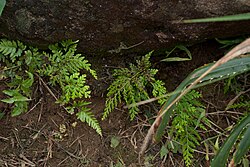 Tubho fern in Taiwan | |
| Country of origin | Philippines |
|---|---|
| Ingredients | Tubho fern |
Tubho tea (sometimes spelled tubha), is a traditional herbal tea of the Ivatan people in the Philippines made from dried leaves of the tubho fern. [1]
 Tubho fern in Taiwan | |
| Country of origin | Philippines |
|---|---|
| Ingredients | Tubho fern |
Tubho tea (sometimes spelled tubha), is a traditional herbal tea of the Ivatan people in the Philippines made from dried leaves of the tubho fern. [1]
Tubho tea is made from the tubho fern, Odontosoria biflora , also known as Sphenomeris biflora and Sphenomeris chinensis subsp. biflora. [2] [3] It is native to Southeast China, Korea, Japan and its offshore islands, Taiwan, and the Philippines. [4]
Tubho tea is not made from fresh fronds of the tubho, instead it is made from mature fronds which have already wilted and dried while still on the plant. They are preferred because they are less bitter. The dried fronds are boiled in water until the water turns dark brown. The leaves are then removed and it is served hot. The leaves may be reused, as long as they still turn the water dark brown when boiled. The tea is traditionally sweetened with brown sugar. However, it can also be consumed similar to other teas, like with cream, honey, or lemon. Some modern versions serve it iced. The taste of the tea is described as slightly bitter and nutty. [1] [5] [6]
The Department of Science and Technology (DOST) has developed a powdered version of tubho tea which is made available in Sabtang town. The DOST plans to develop a method that would enable wider commercial production of tubho tea. [7]
Local Ivatan people claim that the tea is the secret to their longevity and has medicinal benefits. [6] Tubho tea is not cultivated. It is harvested from wild plants in the Batanes Islands in small quantities, particularly in the southernmost islands of Sabtang. They are usually locally consumed or sold to tourists, though some restaurants in other parts of the Philippines serve it as part of their menus. [1] [8]
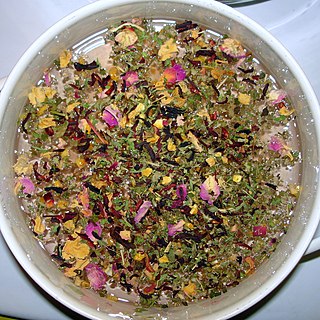
Herbal teas, also known as herbal infusions and less commonly called tisanes, are beverages made from the infusion or decoction of herbs, spices, or other plant material in hot water. Oftentimes herb tea, or the plain term tea, is used as a reference to all sorts of herbal teas. Many herbs are used in herbal medicine. Some herbal blends contain actual tea.

Batanes, officially the Province of Batanes, is an archipelagic province in the Philippines, administratively part of the Cagayan Valley region. It is the northernmost province in the Philippines, and the smallest, both in population and land area. The capital is Basco, located on the island of Batan.

Fiddleheads or fiddlehead greens are the furled fronds of a young fern, harvested for use as a vegetable.

Batan Island is the main island of Batanes, an archipelagic province in the Philippines. It is the second largest of the Batanes Islands, the northernmost group of islands in the Philippines.

The Ivatan language, also known as Chirin nu Ivatan, is a Philippine language of Austronesian origins spoken in the Batanes Islands of the Philippines.

Sabtang, officially the Municipality of Sabtang, is a 6th class municipality in the province of Batanes, Philippines. According to the 2020 census, it has a population of 1,696 people.

Uyugan, officially the Municipality of Uyugan, is a 6th class municipality in the province of Batanes, Philippines. According to the 2020 census, it has a population of 1,380 people.

Mavulis Island is the northernmost of the Batanes Islands and the northernmost island in the Philippines. It is part of the province of Batanes. The island is uninhabited but it is guarded by the military. It is also frequently visited by local fishermen for fishing adventures.

The Ivatan people are an Austronesian ethnolinguistic group native to the Batanes and Babuyan Islands of the northernmost Philippines. They are genetically closely related to other ethnic groups in Northern Luzon, but also share close linguistic and cultural affinities to the Tao people of Orchid Island in Taiwan.
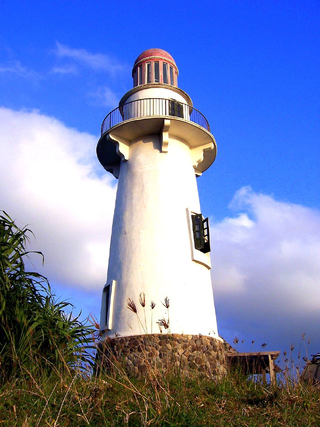
Basco Lighthouse is a lighthouse in the town of Basco in Batanes, the northernmost province in the Philippines. Located in Naidi Hills in Barangay San Antonio, the lush green hills and the open sea provide a beautiful backdrop for the lighthouse. The place can easily be reached by a 1.2-km hike from the Port of Basco.

Ginger tea is a herbal beverage that is made from ginger root. It has a long history as a traditional herbal medicine in East Asia, South Asia, Southeast Asia, and West Asia.

San Vicente Ferrer Church, also known as Sabtang Church, is a Roman Catholic church located near Sabtang Port in Sabtang, Batanes, Philippines. Originally a small chapel in 1785 when the Sabtang mission first opened by the Dominicans, the church underwent few modifications until 1984. A short distance to the right of the church's façade stands a pedestal with a stone statue of Saint Vincent Ferrer, the patron saint of the parish and of the municipality.

Odontosoria chinensis is a fern in the family Lindsaeaceae. Commonly called lace fern, it is native from India to Hawai'i, and south to Sumatra, Borneo and the Philippines, as well as other parts of the tropics and sub-tropics. It is commonly found in forest openings and disturbed areas such as landslides, along trails or roads. It grows in moist, shady areas from sea level to an elevation of 4,000 feet.
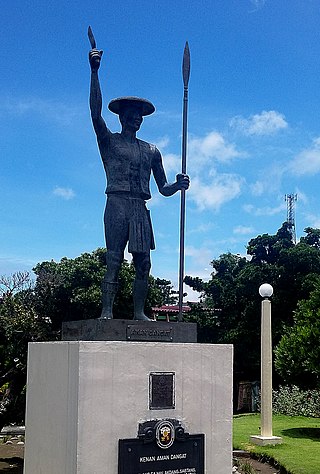
Aman Dangat, also known as "Kenan", was a powerful Mangpus of the town of Malakdang in the island of Sabtang in Batanes, Philippines who had led a revolt against the Spaniards from 1785 to 1791.

Falua, also spelled faluwa, is a traditional open-deck boat of the Ivatan people from the islands of Sabtang and Batan in the Philippines. It is about 8 to 12 m long and has one mast. It can also be propelled by six to ten pairs of rowers. It can carry thirty passengers and is used to ferry goods between the islands. Modern falua are generally motorized. Falua is similar in shape to the chinarem but differs in that it is usually larger and has a flat transom.
Chinarem was a traditional open-deck boat of the Ivatan people from the island of Sabtang in the Philippines. It was around 6 to 8 m long with three or four pair of rowers and a single mast. It was similar to the falua in shape, but differs in that the stern was pointed. It can carry ten passengers and was generally used to ferry goods and people between the islands of Sabtang and Batan. Chinarem is extinct, it disappeared in Sabtang Island around the 1970s.

Tataya are traditional small fishing boats, with or without outriggers of the Ivatan people in the Philippines. They are generally round-hulled and powered by rowers or sails made from woven pandanus leaves. They have several variants based on size and island of origin. The term tataya can also be used for all traditional boats in the Batanes Islands in general, similar to the term bangka in the rest of the Philippines.
Sphenomeris is a genus of ferns in the family Lindsaeaceae.
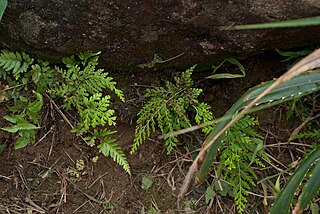
Odontosoria biflora is a species of fern in the family Lindsaeaceae. As with other species in the family, it has been placed in different genera; synonyms include Sphenomeris biflora and Sphenomeris chinensis ssp. biflora. It is native to Southeast China, Korea, Japan and its offshore islands, Taiwan, and the Philippines. The fronds are leathery in texture, with the final segments being wedge-shaped. In the northern Philippines, it is described as "common", being found on ridges and rocks at elevations of up to about 150 m.

Odontosoria is a genus of ferns in the family Lindsaeaceae.